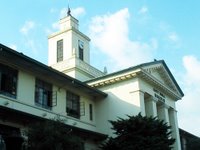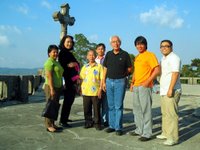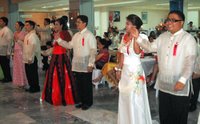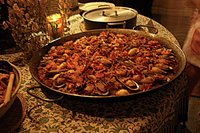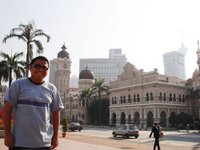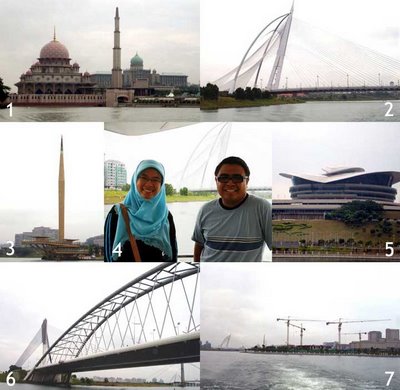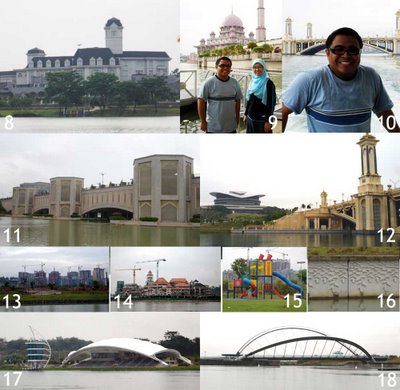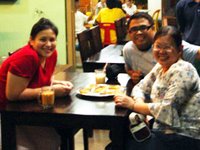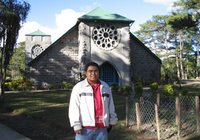 Since we're on the topic of the Cordilleras, I might as well write about my trip to Sagada in the Mountain Province. It was New Year's Day of 2004, I drove straight to Baguio City after a family reunion in Tarlac. There I met up with my SSEAYP batchmate Jonathan Tambol who would accompany to Sagada the next day. So I stayed at their place for the night.
Since we're on the topic of the Cordilleras, I might as well write about my trip to Sagada in the Mountain Province. It was New Year's Day of 2004, I drove straight to Baguio City after a family reunion in Tarlac. There I met up with my SSEAYP batchmate Jonathan Tambol who would accompany to Sagada the next day. So I stayed at their place for the night.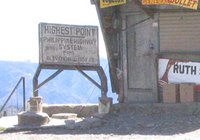 The next morning, we took a mini-bus to Sagada from the bus station near the market. Driving was out of the question given the distance as well as the condition of the roads to Sagada. Buses leave only in the morning since it's dangerous driving to Sagada when it gets dark. The trip took about six hours along a zigzag road which offered great views of vegetable terraces. Along the road is the highest point along the Philippine Highway System. But just like most of our attractions, the sign was neglected. Sigh! I remember visiting the highest point of the Taiwan Highway System in 2003 and the marker was an attraction in itself with a viewing deck where one could marvel at Taiwan's snow-capped mountains. I guess the photo shows how neglected our own marker is.
The next morning, we took a mini-bus to Sagada from the bus station near the market. Driving was out of the question given the distance as well as the condition of the roads to Sagada. Buses leave only in the morning since it's dangerous driving to Sagada when it gets dark. The trip took about six hours along a zigzag road which offered great views of vegetable terraces. Along the road is the highest point along the Philippine Highway System. But just like most of our attractions, the sign was neglected. Sigh! I remember visiting the highest point of the Taiwan Highway System in 2003 and the marker was an attraction in itself with a viewing deck where one could marvel at Taiwan's snow-capped mountains. I guess the photo shows how neglected our own marker is.  Since mini-buses leave Sagada in the morning as well, you will have to stay in Sagada for at least two nights if you plan to take public transportation from Baguio City. When we arrived in Sagada, first thing we did was look around for cheap lodging. We found one easily for PHP100 a night per person. After resting a bit, the cold mountain air was so conducive for an afternon nap, we went for a hike to the hanging coffins. Perched on beautiful limestone cliffs dotted with occasional pine trees, these coffins are treasures of Sagada. We went to bed early that night to rest for our visit to nearby Sumaging Cave the next morning.
Since mini-buses leave Sagada in the morning as well, you will have to stay in Sagada for at least two nights if you plan to take public transportation from Baguio City. When we arrived in Sagada, first thing we did was look around for cheap lodging. We found one easily for PHP100 a night per person. After resting a bit, the cold mountain air was so conducive for an afternon nap, we went for a hike to the hanging coffins. Perched on beautiful limestone cliffs dotted with occasional pine trees, these coffins are treasures of Sagada. We went to bed early that night to rest for our visit to nearby Sumaging Cave the next morning.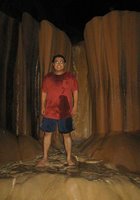
 To enter the cave, you had to get a guide from the Municipal Hall of Sagada. Although we could have gotten a guide just for the both of us, it was going to be quite expensive. So we opted to wait for another group who would be willing to share in the expenses. I think we waited about 30 minutes or so for a group to arrive and good thing they had a pick-up truck so we didn't need to walk to the entrance of the cave. Hehe! The fee for the guide includes the lights for the cave.
To enter the cave, you had to get a guide from the Municipal Hall of Sagada. Although we could have gotten a guide just for the both of us, it was going to be quite expensive. So we opted to wait for another group who would be willing to share in the expenses. I think we waited about 30 minutes or so for a group to arrive and good thing they had a pick-up truck so we didn't need to walk to the entrance of the cave. Hehe! The fee for the guide includes the lights for the cave. Things to remember when you visit Sumaging Cave: (1) you will definitely get wet so wear light shorts and a crew neck t-shirt; (2) no jackets since that would be a hassle when wet; (3) it is best to wear slippers or sandals since at some point in the cave you will take them off and walk barefoot for better grip; (4) make sure you have a waterproof bag for your camera; and (5) celphones and other unnecessary items are best left in the vehicle. The formations inside are awesome. But remember to keep your focus since one mistake and you could fall deep down.
Things to remember when you visit Sumaging Cave: (1) you will definitely get wet so wear light shorts and a crew neck t-shirt; (2) no jackets since that would be a hassle when wet; (3) it is best to wear slippers or sandals since at some point in the cave you will take them off and walk barefoot for better grip; (4) make sure you have a waterproof bag for your camera; and (5) celphones and other unnecessary items are best left in the vehicle. The formations inside are awesome. But remember to keep your focus since one mistake and you could fall deep down. There is also a pool inside where you could swim in but it was January 3 so imagine how cold the water was. Brrrrrrrr! There were times we had to slide down the limestone formations. And at times, the openings were so small, our guide had to teach us how to maneuver into them properly. But the trip was definitely most worth it.
There is also a pool inside where you could swim in but it was January 3 so imagine how cold the water was. Brrrrrrrr! There were times we had to slide down the limestone formations. And at times, the openings were so small, our guide had to teach us how to maneuver into them properly. But the trip was definitely most worth it.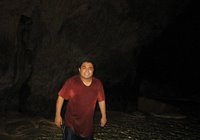 We were back in town just in time for lunch. During the afternoon, we went back to bed again. Hey! The very reason I went to Sagada was to relax and enjoy the mountain air since I was quite stressed after a very hectic December due to the Giant Lantern Festival among others. Hehe! In fact, I had a fever before driving up to Baguio. And for some reason, it was gone as soon as I got to Sagada. During the visit to the cave, I actually saw Daks Quinones, a brod of mine, who was with his friends. They invited us to join their group after dinner for a drink or two and we did. But we didn't stay up too late.
We were back in town just in time for lunch. During the afternoon, we went back to bed again. Hey! The very reason I went to Sagada was to relax and enjoy the mountain air since I was quite stressed after a very hectic December due to the Giant Lantern Festival among others. Hehe! In fact, I had a fever before driving up to Baguio. And for some reason, it was gone as soon as I got to Sagada. During the visit to the cave, I actually saw Daks Quinones, a brod of mine, who was with his friends. They invited us to join their group after dinner for a drink or two and we did. But we didn't stay up too late.We were up early the next morning at 5 a.m. since there was a limited number of mini-buses and seats were scarce. If we got left behind, we would have to stay another night. We weren't the only ones waiting for a bus. But after much waiting, we finally got seats and were off to Baguio again arriving shortly after lunch.
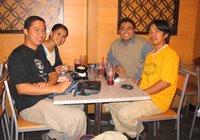 In the evening, we met up with another SSEAYP batchmate Edwin Antonio who was taking around Rose, another SSEAYP batchmate who was visiting from Indonesia. We had dinner. Then it was off to the Mansion House. After going around, I was off to Pampanga. Now that it's so hot in Manila, maybe I could consider visiting Sagada again.
In the evening, we met up with another SSEAYP batchmate Edwin Antonio who was taking around Rose, another SSEAYP batchmate who was visiting from Indonesia. We had dinner. Then it was off to the Mansion House. After going around, I was off to Pampanga. Now that it's so hot in Manila, maybe I could consider visiting Sagada again.




